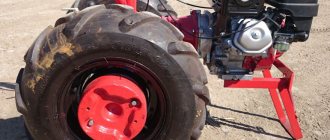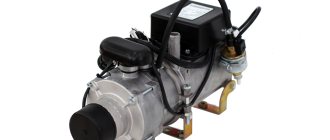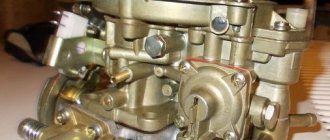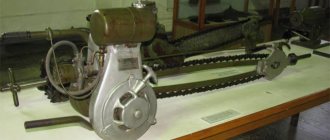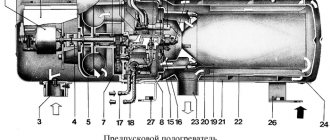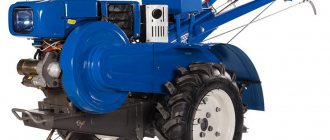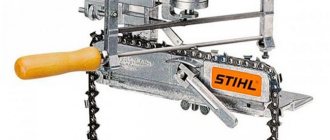vanguard 7.5 unstable engine operation
Dear forum users, please help. I have a Neva walk-behind tractor with a Vanguard 7.5 engine. It started to work unstably. It’s like I’m giving it gas and turning it down. It starts the first time.
Replaced the air filter. , spark plug, washed the carburetor, jets and the result is the same. The lever on the engine block that makes the gas more and less during operation twitches (should it even move involuntarily during operation?) and at the same time the carburetor flap opens and closes. When I hold the spring on the carburetor it works smoothly, I immediately drop it as if I gave it a sharp boost of gas. Three of my friends already have this situation. Is it possible to reduce the fuel supply? Vasily Fed. , What about thinking? 99% similar to the operation of a centrifugal regulator. I haven’t touched this myself. Read and look through the work of such regulators. You don’t need to be particularly afraid of this, but it’s understandable that you want smooth work. There may be some kind of design defect in the operation of the regulator. On my gasoline internal combustion engine the idle also floats slightly. I don't feel like taking it apart.
I fluctuate not only at idle but also when I give it gas, but I just have to listen or step aside
Vasily Fed. wrote: the speed fluctuates not only at idle but also when I give it gas
Well then, YES. We need to look for the reason.
Vasily Fed. wrote: Three comrades already have this situation
Looks like there's a problem. Maybe take a closer look at the play on the carburetor control rods. It is clear that they are there, but they must be within reasonable acceptable limits.
Don't touch the speed controller yet. It is stupid and cannot be the cause of the unstable speed. Most often, the engine starts to malfunction like this due to a faulty spark plug. Replace with another one, not necessarily “native” - as long as it fits in size. And try domestically produced ones - they work better with our filthy fuel than imported ones. The second (somewhat less common) reason is a clogged fuel system. Now, if replacing the spark plug doesn't help, get into the carburetor and fuel lines. And do not twist the adjusting screws (if there are any), but simply open and clean. And change the gas station, it is quite possible that the problem is the quality of the fuel. But we usually adjust the regulators when the owners climb in themselves and start trying to change the factory settings. Don’t touch the regulator, don’t add more work to the services - now the blockage has already begun
Vasily Fed. wrote: When I hold the spring on the carburetor it works smoothly, I drop it right away as if I suddenly gave the gas Takaya
So try a slightly tighter spring, or tighten this one with something.
Olegych wrote: Don't touch the speed control yet. It is stupid and cannot be the cause of the unstable speed. Most often, the engine starts to malfunction like this due to a faulty spark plug. Replace with another one, not necessarily the “native” one - as long as it fits in size. And try domestically produced ones - they work better with our filthy fuel than imported ones. The second (somewhat less common) reason is a clogged fuel system. Now, if replacing the spark plug doesn't help, get into the carburetor and fuel lines. And do not twist the adjusting screws (if there are any), but simply open and clean. And change the gas station, it is quite possible that the problem is the quality of the fuel. But we usually adjust the regulators when the owners climb in themselves and start trying to change the factory settings. Don’t touch the regulator, don’t add more work to the services - now the blockage has already begun
In! That's what I wanted to say, but I'm not a pro. Why are people afraid of these regulators? Because it’s not clear how they work? (like my wife, she is afraid of everything she doesn’t understand. That’s why she doesn’t go near the computer.) I just wanted to say that the reason should be looked for elsewhere: the spark plug, the carb, the fuel supply, but in no case not in the regulator itself. I understand that it also breaks, but this is an extreme case. Thank you Olegich for stopping by!
Pavel003 wrote: try a slightly tighter spring, or tighten this one with something.
I wouldn't recommend it! Then you will be tortured to put it in place! I also went through this on Krota.
Vasily Fed. wrote: Dear forum users, please help
I'll try, I also have a Neva with the same engine and also had the same symptoms. It can be treated by blowing out the idle jet. When you remove the carburetor, look at it from the side where it is attached to the engine, there you will see the throttle valve and in front of it in the channel itself on the right there is a small hole, you need it I blew it out with a compressor. I have already cured three engines in this way. It started with my Honda, I took it apart three times until it was finished. And a week ago my neighbor’s Neva with a Briggs with Intek was also cured. Just very carefully disassemble the carburetor and remember what is in place and to the rods and springs no need to bother, just put them in the right place later. Tell me, do you start a hot engine with the choke fully open, or do you cover it? I even start a hot engine with the choke closed, and a cold one with the choke closed, and it’s been like that since new.
On the old Tekamsi engine, I twisted the speed controller this way. The revolutions began to float, and I’m very “smart” - I read about the speed controller. Well, I decided to play with the springs and move them to other holes. Then, I remember, I also washed and blew out the carburetor, and when I put the washed one back in place, the revolutions became even, but more than needed, and much more. I was tired of exhibiting it later, because I didn’t write it down or sketch it when it melted away. Then I sat down and thought deeply. It seems to me that a working regulator reacts to what the ignition, fuel supply and load do to the engine. If there is no load, then the reason is either in the ignition (which is less likely) or in the supply of the fuel mixture (which includes both gasoline and air). And the regulator is most often in good working order and tries to bring the speed in order if for some reason they begin to rise or fall when the speed control lever is stationary. Perhaps I'm wrong. Then teach.
newzubok wrote: Then I sat down and thought hard. It seems to me that a working regulator reacts to what the ignition, fuel supply and load do to the engine. If there is no load, then the reason is either in the ignition (which is less likely) or in the supply of the fuel mixture (which includes both gasoline and air). And the regulator is most often in good working order and tries to bring the speed in order if for some reason they begin to rise or fall when the speed control lever is stationary. Perhaps I'm wrong. Then teach.
Everything is absolutely true! Ignition is rare, usually carb, and the regulator itself is out of the ordinary - almost fantastic.
newzubok wrote: more than needed, and much more.
Of course, it’s complicated, about like an andron collider. Think about where and what you write. You can write in the same way about the carburetor screws. The spring tension regulates the speed; the harder the spring pulls, the higher the maintained speed will be. True, all this applies to UD 15, 25 and UD 1.2. But the speed regulator is also a regulator in Africa.
newzubok wrote: It seems to me that a working regulator reacts to what ignition, fuel supply and load are doing to the engine. If there is no load,
The adjustment is made by supplying fuel. On UDashki, the regulator always closes the valve (the rod pushed out by the gouziks presses on the lever towards closing), and a spring opens it. The balance of the tension force of the spring and the pressure force of the diverging weights maintains constant speed. On DM 1 this is not so bright expressed, and the spring costs IDIOTICALLY (more precisely, in European terms, I would say through the ass), but in order to save money, they send their women to the panel, so there is nothing surprising.
valerich wrote: And the regulator itself is almost fantastic.
Much like the Soyuz spacecraft.
newzubok wrote: Perhaps I'm wrong. Then teach.
And one more point. When the forces are measured (and change) in tens, or even hundreds of grams, an error in adjustment of 10-20 grams is not significant (this is with our Udeshki). And when these forces are within the range of 20-50 grams (weak, delicate springs) then the adjustment is quite a nasty thing, it’s hard to catch the right moment, but it’s possible. Our “specialists” at DM 1 throw out both the regulator and the KMB 5 carb; both worked for me.
Sanya 17 wrote: it can be treated by blowing out the idle jet.
Very possible. But of course this is not always the reason.
Pavel003 wrote: About the same as the Soyuz spacecraft.
Not. Cooler! What's his name, who was supposed to fly to Mars. And fell into our ocean. Phobos like?
Walk-behind tractor engine malfunctions: we solve the problem on our own
Like any equipment, the walk-behind tractor requires timely maintenance and repair. And it is advisable to entrust their implementation to specialists who have the necessary tools and equipment and know their job well. However, if you are also familiar with the structure of internal combustion engines and understand the topic of mechanical engineering, then you can do a lot of what may be required to restore the machine’s performance on your own.
Do-it-yourself walk-behind tractor repair
Most models consist of the same parts, so you can repair the main components yourself.
Figure 1. Standard drawing of a walk-behind tractor
Each walk-behind tractor consists of a base frame, a gasoline or diesel engine, a fuel tank, a rotor for attaching cutters, wheels and a bracket for fixing attachments
The most important component is, of course, the engine, the successful operation of which will determine the operation of the equipment (Figure 1). In addition, modern models have fuel supply, cooling, ignition and gas distribution systems, and the occurrence of malfunctions in them can also lead to the unit stopping operation
Principle of operation
The main function of the walk-behind tractor is to loosen the soil using special cutters that are attached to the frame of the device.
In addition, the equipment can be used to loosen rows in the process of growing agricultural crops, and special attachments are useful for harvesting. Simple models (cultivators) consist of several wheels and handles that are used to control the equipment. The handles contain the buttons necessary for control. More powerful and modern models are mini-tractors without a cabin. In this case, control is carried out by buttons and pedals located on the dashboard.
Types of walk-behind tractors
Despite the fact that walk-behind tractors are produced by a wide variety of manufacturers, all such equipment is usually divided into types depending on weight and power (Figure 2).
According to this criterion, walk-behind tractors are:
- Ultralight – weighing up to 15 kg;
- Light (about 40 kg);
- Medium – from 45 to 60 kg;
- Heavy (more than 60 kg).
Figure 2. Main types of equipment and attachments As a rule, all types of equipment are equipped with an internal combustion engine with a power of 1.5 to 10 horsepower. This is necessary so that even an ultra-light model can successfully cope with loosening the soil in areas with heavy and dense soils.
Main malfunctions of walk-behind tractors
Diesel and gasoline engines have different motor resources. For the former, the normal figure is 4000 m/h, but the latter are capable of providing only 1500 m/h. Despite this, diesel models of walk-behind tractors are not in high demand. After all, both when purchased and during operation they are much more expensive. Therefore, most likely, you are working with a walk-behind tractor equipped with a gasoline (carburetor) engine.
All breakdowns that may occur during the operation of agricultural mini-equipment can be divided into two categories:
- Engine faults:
- startup problems;
- malfunctions.
- Malfunctions of other components and mechanisms:
- improper clutch operation;
- breakdowns in the gearbox;
- problems with the chassis;
- control and automation malfunctions;
- malfunctions of walk-behind tractor systems (cooling, lubrication, etc.).
In many ways, the success of repairing a suddenly broken machine depends on the correctness of the diagnosis. As for maintenance, it is carried out precisely in order to identify small faults that will later lead to serious ones.
If you do not have the necessary knowledge, premises, tools and materials necessary to service and repair the motor, entrust the work to a specialist!
Repair
It is not possible to repair a cultivator yourself in all cases. The following work is most often carried out:
- Setting up the ignition system.
- Solving problems with the power system.
- Replacement of external parts.
If problems arise with the internal components of an internal combustion engine, it will be difficult to replace them yourself, because To do this you need to have special skills and have the required tools.
Gas engine
Repair of gasoline cultivators includes:
- Replacing filters.
- Setting up the carburetor.
- Ignition settings.
Gasoline devices are less demanding to use.
Fuel supply problems
If attempts to start the walk-behind tractor are unsuccessful, this means there is a malfunction in the engine or starting system. In order to determine the source of the breakdown, you first need to check the spark plugs.
If the spark plugs are dry, this means that the fuel mixture is not entering the engine cylinders. There may be several reasons for this:
- there is no fuel in the tank;
- the fuel supply valve is closed;
- the hole in the gas tank plug is clogged;
- foreign objects have entered the fuel supply system.
To resolve fuel supply problems, you must:
- Fill the tank of the walk-behind tractor.
- Open the fuel tap.
- Clean the drain hole located in the gas tank cap.
- Remove the fuel valve, drain the gasoline from the tank and rinse it with clean gasoline. After this, you should remove the connecting hose located on the carburetor side and blow it out together with the carburetor jets without disassembling the latter using a fuel pump.
If fuel enters the carburetor but does not reach the cylinder, the problem is in the carburetor itself. To eliminate it, this unit must be removed, disassembled and cleaned. Well, after that - assemble and install in place. Therefore, before performing all the necessary manipulations, it will not hurt to refresh your memory of the structure and principle of operation of the carburetor.
Preparing the walk-behind tractor for start-up
In the instructions, manufacturers always indicate how to start the walk-behind tractor correctly. However, not everyone wants to waste time reading long pieces of paper and start work without familiarizing themselves with the operating rules. This is fraught with serious damage. It will not be possible to return equipment that was used for other purposes or broken due to the fault of the owner under warranty. If you never manage to start the engine even after several attempts, the reason may not be a bad part.
To make sure that the walk-behind tractor engine or starting system is faulty, you must try to turn it on, following the instructions exactly. If the reason turns out to be incorrect actions, there will be no need to contact for repairs. Sometimes it happens that the MB does not start and immediately stalls due to a manufacturing defect. In this case, you can safely go to the warranty center to process a return.
When communicating with an employee, it is important to inform that everything was done according to the instructions and a breakdown could not have occurred due to the owner’s fault.
To start the walk-behind tractor:
- Check the oil level, even if it was filled just a day ago. Sometimes sellers convince you that the required amount of liquid has already been poured into the tank. You can’t trust words, because... An attempt to start a walk-behind tractor without oil will lead to breakdown and will not be accepted under warranty.
- Fill with fuel. The method for opening the tank varies depending on the model, so you need to read the instructions. For some types of engines, gasoline must be mixed with oil. The proportions are also indicated in the technical book.
- Open the petrol tap. Before doing this, you must move the pump lever to the “Start” position. The name varies depending on the manufacturer.
- Pump fuel from the tank using the starter and turn on the ignition. Then you need to pull the starter and move the choke lever to the “Operation” mode. If everything is done correctly, the walk-behind tractor will start.
The described scheme of action is relevant for a gasoline engine without an electric starter, for example the Lifan model. To start a diesel walk-behind tractor, you will have to spend more time. The main problem of such equipment is its instability to frost. When the outside temperature drops, the fuel freezes, so the MB has to be warmed up before starting. The first attempt to turn on may fail if you do not bleed the system with the starter, because Everything inside is airy. Then pump the decompressor several times. Some models indicate the exact time of such preparation. Usually it is enough to do this 5-6 times, and then pull it to the starting position. If all the steps are completed correctly, to start the walk-behind tractor, just press the decompressor and turn on the starter.
Engine system malfunctions during startup
If, when checking the spark plugs, they turn out to be wet, i.e. fuel flows normally, but the engine does not start, the problem may be the following:
- Ignition system failure:
- there is a characteristic carbon deposit on the electrodes of the spark plugs (it is necessary to clean the spark plugs with emery, after which they should be washed with gasoline and dried);
- the gap between the electrodes does not correspond to those specified by the manufacturer in the engine operating manual (the gap is adjusted by bending the side electrode to the required dimensions);
- the insulators of the spark plugs or high-voltage electrical wiring are damaged (faulty spark plugs and wiring must be replaced);
- the STOP button is shorted to ground (for normal engine starting, the short circuit must be eliminated);
- the contacts in the spark plug brackets are broken (the contacts should be put in order);
- the gap between the magnetic shoe and the starter does not correspond to the standard value (the gap needs to be adjusted);
- Defects were detected on the stator of the ignition system (the stator must be replaced).
- Air leaks through carburetor seals, spark plugs, plug and cylinder heads, as well as carburetor and engine cylinder connections.
Engine malfunctions
The engine does not start. If we are talking about a gasoline engine, when troubleshooting, it is necessary to consistently check all possible causes of problems, namely:
- Turn on the ignition.
- Availability of fuel in the tank.
- Opening the fuel tap.
- The condition of the carburetor air damper (it should be closed when starting a cold engine).
- Fuel entering the carburetor. To do this, you need to fill the float chamber by pressing down the float button (fuel should start pouring out of the hole in the float chamber cover), or disconnect the fuel hose from the carburetor and check whether gasoline flows freely. If the fuel flows in too thin a stream or does not flow at all, this may indicate a dirty fuel filter in the tank or a clogged air valve in the tank cap. Repairing a walk-behind tractor in this case will come down to cleaning the filter or valve.
The supply of fuel to the engine cylinder may be indicated by the condition of the spark plug, which in any case must be checked when troubleshooting the ignition system. The spark plug is unscrewed from the cylinder cover, having previously disconnected the wire, and inspected.
https://www.youtube.com/watch?v=VN0Lyts7frs
If it is dry, this means that the fuel mixture is not supplied to the cylinder. And if before this it was established that gasoline is entering the carburetor, then the reason for the engine not starting may be in the carburetor - contamination of its filter mesh, clogging of the nozzle or some other malfunction.
A wet spark plug indicates that fuel is entering the cylinder. Sometimes the walk-behind tractor does not start due to an excess of fuel mixture, so if there is too much gasoline on the spark plug, you need to dry the cylinder by thoroughly “pumping” the engine with a manual starter with the spark plug turned out. Before doing this, you need to shut off the fuel supply.
If the spark plug is contaminated with carbon deposits, it should be cleaned with gasoline and fine sandpaper. It is also necessary to check the gap between the electrodes and, if necessary, adjust it in accordance with the requirements of the operating manual. Typically the gap should be about 0.8mm.
After this, you need to check for the presence of a spark - attach a wire to the spark plug, press its metal part to the cylinder cover and simulate starting the engine with a starter. If the spark plug is working properly, a spark will occur between the electrodes. Sometimes it happens that a spark occurs, but it is so weak that it is not enough to ignite the fuel. If you have doubts about the strength of the spark, you need to check the operation of the engine with a new spark plug.
The absence of a spark may mean a faulty spark plug, lack of contact in the electrical circuit, a violation of the gap between the ignition coil and the magnetic circuit, or a malfunction of the electronic ignition coil. All these elements must be checked. A faulty spark plug and ignition coil must be replaced.
If the walk-behind tractor is equipped with an electric starter, the engine may not start due to a discharged battery, a blown fuse, or a faulty starter. You need to check the battery charge, replace the fuse, repair or replace the starter.
The engine does not develop power. If the walk-behind tractor engine starts but does not develop power (runs intermittently, stalls or does not gain speed under load), the following malfunctions may be possible reasons for unsatisfactory operation.
The air filter is dirty, resulting in insufficient air entering the carburetor, and the fuel mixture is over-rich. Proper maintenance of a walk-behind tractor involves periodically cleaning the air filter, however, very dusty work may require more frequent cleaning.
It is necessary to check the condition of the air filter and, depending on its material, clean it using one of the appropriate methods. The paper filter is cleaned by lightly tapping it on something hard and blowing it with a vacuum cleaner, the foam filter is washed in water with detergent and dried, the mesh filter is blown with a vacuum cleaner, etc. When the filters reach the end of their service life, they must be changed.
Low quality fuel. Bad fuel must be replaced with one recommended by the manufacturer.
The ignition system is faulty. You need to check it as described above. Clean the spark plug and adjust the gap between its electrodes, check for damage in the electrical circuit and the gap between the coil and the magnetic circuit (if this is provided for in the walk-behind tractor repair instructions).
Sometimes the engine cannot develop power due to the muffler being clogged with combustion products. In this case, you need to disassemble the muffler and check its condition, if necessary, wash it in gasoline and clean it with a car wash to remove carbon deposits using detergents.
The non-removable muffler is dried with a hairdryer after washing. Remember that carbon deposits contain substances that are carcinogens, and dry cleaning, which could result in their inhalation, is unacceptable. When removing the muffler, plug the engine exhaust hole with a clean rag.
Dirty or incorrect adjustment of the walk-behind tractor carburetor. It is necessary to remove and clean the carburetor, and then adjust it, if this is provided for in the walk-behind tractor instructions.
A drop in engine power can be caused by a decrease in compression due to wear of the cylinder-piston group, the formation of scoring and scratches on the cylinder and piston, “retraction” in the grooves or breakage of the piston rings. In this case, check the compression by connecting a compression gauge to the spark plug hole and turning the engine shaft with the starter.
Normal compression is characterized by a value of at least 8 atm (normal compression can be indicated in the engine characteristics). When measuring it, you need to take into account that the presence of a decompressor in the engine can affect the readings of the compression meter.
Diesel engine does not start. For most users, repairing and tuning a walk-behind tractor with a diesel engine is a more difficult task than repairing a walk-behind tractor with a gasoline engine. Not so much, perhaps, because of the design complexity of the diesel engine, but because of the lack of experience, since household devices are usually equipped with gasoline engines.
The most common faults or conditions that may prevent diesel engines from starting are outlined in the table below. A detailed list of diesel malfunctions and methods for eliminating them are set out in the operating instructions for specific diesel walk-behind tractors.
| Cause | Remedy |
| The weather is too cold. | Pour hot water into the radiator. |
| The fuel has frozen and lost its fluidity. | Use the correct grade of fuel or heat it up. |
| The nozzle is clogged. | Clean or replace the nozzle. |
| Insufficient injection pressure. | Adjust pressure. |
Insufficient cylinder compression (engine cranks too easily with starter).
|
|
Malfunctions of the walk-behind tractor engine during operation
The units and components of motors that are installed on mini-agricultural equipment are subject to significant loads. They can also fail during operation of the unit, which will very quickly lead to serious failures.
If you detect suspicious noises, jerks and disturbances in the operation of the walk-behind tractor systems, it is very important to immediately turn off the engine and then let it cool down - only after that will it be possible to fix the problem.
If during operation the motor begins to gain speed on its own, i.e. is “peddling”, most likely this means that the fastening of the regulator and thrust levers has become loose. In this case, the user will have to readjust the motor control drive.
Sometimes, when the throttle is fully open, the engine does not accelerate when the throttle is pressed, but rather begins to lose power until it comes to a complete stop. This is a clear sign of overheating, so you need to turn off the walk-behind tractor and wait until its components have completely cooled down. After this, you should check the oil level in the crankcase, and also check the cleanliness of the finned surfaces of the blocks and cylinder heads.
Under increased loads on the engine, it may seize. There may be several reasons for this:
- there is not enough oil in the crankcase;
- a nadir has formed on the lower head of the connecting rod;
- The connecting rod or oil sprayer has completely failed.
If the motor of a walk-behind tractor is jammed, you will have to disassemble it and check the condition of the main components and components: faulty, deformed, melted, etc. subject to replacement.
Walk-behind tractor engine is difficult to start when hot
The question of why the motor of a walk-behind tractor stalls when heated is quite simple to solve. The whole essence of the problem lies in the excess air supplied to the carburetor of the walk-behind tractor. Part of it is mixed with a mixture of gasoline and motor oil, and the second part cools the carburetor. As a result, the carburetor temperature becomes much lower than the temperature of the unit’s engine. This problem is observed only during the operation of the walk-behind tractor. When its engine is turned off, the carburetor, on the contrary, is heated by the hot walls of the engine.
As the carburetor of the walk-behind tractor heats up, the remaining fuel begins to actively evaporate, filling all the voids in the walk-behind tractor, including the air filter and the intake manifold. This leads to the complete disappearance of fuel, which is why the walk-behind tractor will not start when the engine is hot.
To fix this problem, it is necessary to follow a certain algorithm every time you start the walk-behind tractor “hot”. Your main task is to ensure that the mixture combines so that the engine can start. To do this you will need:
- When starting a hot engine, squeeze the throttle trigger halfway;
- Do not try to press the gas trigger over and over again, otherwise you will only aggravate the situation, since when you press the gas trigger frequently, the fuel pump will supply new portions of fuel to the carburetor, which will lead to flooding of the engine;
- After several attempts to start with the gas trigger pressed halfway, you will start the engine of the walk-behind tractor, after which you will need to rev it up 2-3 times and continue working.
This procedure will eliminate the increased load on the hot motor, due to which the main parts and mechanisms of the walk-behind tractor will not be subject to excessive wear.
All of the above methods will help to effectively cope with typical breakdowns of the most famous manufacturers of walk-behind tractors. They are equally successfully used by owners of agricultural implements of the Honda, Agro, Cascade and Neva brands.
Auto mechanic, specializes in agricultural equipment
Currently, special equipment is used quite often in agriculture and gardening. Here, equipment such as a walk-behind tractor stands out separately. These devices allow you to quickly and efficiently process the soil. However, like any type of equipment, such equipment can also fail. In this case, you need to consider what to do correctly if the Agro walk-behind tractor is faulty and does not start.
Other common engine starting problems
What to do if the walk-behind tractor engine operates intermittently and does not develop the required power? There may be several reasons for this behavior:
- Air filter clogged.
Air does not enter the carburetor, which means the fuel does not burn well - the filter will have to be cleaned or replaced.
Residues of fuel, as well as the products of its combustion, form a thick coating on the internal walls of the muffler, which must be removed.
In this case, the assembly will have to be removed, disassembled and all its components properly cleaned. After this, the carburetor must be assembled and adjusted correctly.
- Wear of the cylinder-piston group.
Temperature and high loads take their toll, and even the strongest metal wears out and deforms over time. Such parts should be replaced immediately, otherwise you may pay for it with irreparable damage to the engine itself.
- Broken ratchet housing or ratchet
The presence of this problem is indicated by the absence of crankshaft movement when starting the engine. To replace the clutch housing and ratchet, you will have to completely disassemble the starting unit.
- Loosening the screws securing the starter housing to the engine housing.
If the starter cord does not return to its original position, the starter needs to be adjusted. To do this, the screws are loosened, and the position of the knot is set by hand so as to ensure normal return of the cord.
A fairly common reason for the starter cord not returning is the failure of the starter spring - it will have to be replaced.
Competent maintenance of its main units and components significantly increases the service life of any equipment. Efficiency of replacement of worn-out spare parts is also of great importance. Therefore, if the slightest failures or malfunctions occur, they should be addressed immediately - in the end, this will prevent much more serious and expensive problems.
What to do if the cylinder block engine does not start?
If the walk-behind tractor does not have hot turns, fault diagnosis is carried out in the following sequence:
- After several unsuccessful starting attempts, inspect the spark plug as described above. If possible, it is better to replace it with a new one immediately to completely eliminate the problem from now on;
- Check the compression and vacuum levels in the gas tank;
- In a dark room to see if the wiring is sparking;
- Make sure a spark forms when heated. In addition to the spark plug, a faulty ignition coil can also prevent sparks.
Other reasons for refusal include:
- Lack or incorrect filling of oil, due to which the triggered level sensor blocks the operation of the engine part;
- Failure of the valve in the fuel tank, which is supposed to maintain gasoline pressure. As a result, its liquid content does not enter the carburetor.
Repairing chassis, especially their powertrain, is a demanding business that requires literacy and good dexterity. This applies not only to domestic favorites. Motoblocks Grass, Cascade, Agro, but also imported ones, for example, Honda. But this does not mean that repairing them yourself is impossible. With minimal knowledge and following our recommendations above, you can solve any problems at home.
Source
Motoblock. This is a useful economic unit that greatly simplifies land and home operations. Like any other piece of equipment, units can break. But it is quite possible to repair a walk-behind tractor engine with your own hands, following simple recommendations.
Engine power has dropped
It often happens that a previously serviceable walk-behind tractor, which has served for several years, suddenly loses power.
— If the power has dropped after long-term storage
, perhaps the walk-behind tractor was stored with a wet carburetor and fuel system, which led to deposits. In this case, you can start the engine and let it run, often after these actions the power is restored. If you have the skills, you can disassemble and clean it; if you don’t have the skills, it’s better to contact the service.
— The carburetor may be clogged
. Clean
— Fuel hose is clogged
. Need to blow it out.
— Possible loss of performance of the crankcase cuff
. Remove the casing and gearbox cover and inspect the cuff.
— Carbon deposits on the cylinder, muffler
. Clean.
Engine won't start
- If the engine is tilted
, must be placed horizontally.
— Fuel may not be supplied to the carburetor
. The fuel system needs to be disassembled and purged with air.
— The filter may be clogged
. The filter needs to be replaced or cleaned.
— The outlet hole in the gas tank cap may be clogged
. Needs cleaning.
- Perhaps it's the candle
. You need to check the connection of the wires, the engine stop buttons, remove the spark plug and clean it. Replace if necessary.
— Possible magneto failure
. Replace.
The starter squeals, the cord comes out
— It may squeal if there is a lot of grease on the balls. You need to clean the balls and the places in the ratchet where they are inserted.
The cultivator made several pops, the speed began to “float”
— Most likely, the power system is not coping, or the fuel level in the tank is low, the float axis may be skewed and debris may have gotten under the needle valve, you need to remove everything and check the air filter and jets.
The material will be updated, we are waiting for comments with questions, stories about identifying a particular malfunction and ways to eliminate it. Also, see the answers to questions about a particular walk-behind tractor model on its description page.
Why does the walk-behind tractor stall under load?
A fairly common problem is that the equipment stalls after 5 minutes of operation.
Often the reason is a failure in the fuel supply and ignition problems. If the equipment stalls during operation, you need to check how well the fuel is supplied:
- The candle is taken out and examined. It is overdried - this indicates a lack of fuel;
- There must be enough fuel in the gas tank for the normal functioning of the machine;
- The condition of the fuel valve is inspected. It may simply be blocked. Sometimes it is enough to open it for further use of the unit.
The walk-behind tractor starts and stalls if there is a problem with the ignition. First you need to check the spark plugs. Wet elements indicate breakdown. It is necessary to re-adjust the ignition system of the equipment.
Resetting is done as follows:
- The cover is removed, which protects the parts of the ignition system;
- The engine flywheel rotates until the contacts in the magneto open;
- A special feeler gauge measures the gap from the “anvil” to the “hammer”;
- The flywheel rotates until the piston is compressed. The latter must reach its peak;
- The flywheel turns again until a characteristic knocking sound is heard, which will indicate the operation of the overrunning clutch;
- The flywheel turns in the other direction until the mark of this element coincides with the mark on the body of the unit;
- The gap from the interrupting contact to the cam is set to 0.3 millimeters;
- The cam is fixed with a screw, which is located above the element, and a protective cover is installed in the equipment body.
If the above steps are performed correctly, the walk-behind tractor will not stall under load. When tilted, equipment may stall if there is not enough fuel in the gas tank. The unit must be installed straight and the starter cable removed. If the engine starts, you need to fill the tank with fuel.
Causes of walk-behind tractor malfunctions and ways to eliminate them
Malfunction: walk-behind tractor stalls under load
If the walk-behind tractor operates normally for a few minutes and then stalls, the cause is usually a failure in the fuel supply or problems in the ignition system.
To find out what is the cause of the malfunction of the walk-behind tractor, you must first check how the fuel is supplied:
- take out the spark plug and inspect it - if it is dry, it means there is not enough fuel;
- check whether there is enough fuel in the gas tank of the walk-behind tractor;
- make sure that the fuel tap is open - a closed tap can be a simple reason that the walk-behind tractor stalls.
If the problem is a malfunction of a gasoline walk-behind tractor in the ignition system, it must be re-adjusted as follows:
- remove the cover protecting the ignition system;
- turn the engine flywheel until the contacts in the magneto open;
- using a feeler gauge, measure the distance from the anvil to the hammer;
- turn the flywheel until the piston is compressed to maximum;
- turn the flywheel again until a knock appears, indicating the operation of the overrunning clutch;
- turn the flywheel in the other direction so that its mark coincides with the mark on the body of the walk-behind tractor;
- set the distance from the interrupting contact to the cam to 0.3 mm;
- fix the cam with the screw located above the element;
- install the cover into the walk-behind tractor body.
If the adjustment is made correctly, the walk-behind tractor will not stall during operation.
Malfunction: the walk-behind tractor operates jerkily, intermittently or at reduced power
If a walk-behind tractor with a gasoline or diesel engine begins to work intermittently, you must immediately turn off the unit and begin troubleshooting.
Continuing to work with a faulty walk-behind tractor means leading it to more serious breakdowns.
What to do:
- if the engine of a gasoline walk-behind tractor makes reverse movements, it is necessary to rinse the pump and hoses for supplying fuel and replace the fuel with a higher quality one;
- when the walk-behind tractor operates jerkily due to incomplete warming up of the engine, you need to turn off the engine, let it cool completely, start it and warm it up for ten minutes;
- if engine power has dropped, you need to check and clean the filter system;
- If the ignition magneto wears out, the part must be replaced with a new one.
Malfunction: the walk-behind tractor smokes and stalls, the muffler makes unusual sounds
Possible causes of the malfunction:
- too much motor oil in the fuel;
- the ignition is set incorrectly;
- The fuel in the engine cylinder does not burn completely.
Troubleshooting methods:
- if there is excess oil, drain the fuel, flush the fuel pump and hose system, and add new fuel;
- check that the gap between the electrodes is set correctly;
- if it becomes obvious that the fuel is not completely burned, disassemble the piston system, wash and dry the cylinder, and adjust the carburetor correctly.
Malfunction: the walk-behind tractor starts, but quickly stalls
This malfunction occurs if there are problems with the contacts. What to do:
- clean the candle;
- check the integrity of the wires;
- set the correct distance between the electrodes.
Another reason for the malfunction is that the carburetor is dirty and not enough fuel is supplied. Then you need to replace the fuel and reduce the amount of oil.
Malfunction: the walk-behind tractor stalls when heated
This problem occurs due to excess air entering the carburetor. In case of such a malfunction, the throttle trigger should be squeezed halfway. After starting the engine, you need to give it a good gas before starting work.
If you cannot cope with the malfunctions of the garden walk-behind tractor, the walk-behind tractor stalls, the walk-behind tractor does not start, contact the Alfa-Rost walk-behind tractor repair shop in Rostov-on-Don. We guarantee high-quality repairs of gasoline walk-behind tractors using original components, which are always available in our warehouse.
When your hitherto trouble-free walk-behind tractor begins to act up, it is very annoying. It’s doubly annoying when this happens in a situation where there’s a lot of work and without a walk-behind tractor, it’s like without hands. It seems to start normally, but as soon as you give it a load, it immediately sneezes and stalls. What is the reason for such “betrayal”?
Why does the walk-behind tractor work intermittently?
There are other faults that are worth considering:
- The walk-behind tractor engine is running backwards. The reason is often the use of bad fuel. It will not be enough to replace the fuel. The pump and fuel supply hoses are washed;
- The equipment works in jerks. The engine does not warm up completely. You need to turn off the engine and wait for it to cool completely. Then restart it and warm it up for at least ten minutes;
- The engine does not pull, therefore the engine power decreases. The filter system is checked and cleaned. The problem can be caused by wear of the ignition magneto. In this case, the part is replaced.
Owners of both gasoline and diesel vehicles may encounter such problems. Regardless of the specifics of the breakdown, you must urgently stop using the unit and start fixing the problem.
What malfunctions threaten walk-behind tractors?
A garden walk-behind tractor is a very useful thing in the household.
With a good walk-behind tractor, work on personal plots goes much faster. But walk-behind tractors, like other household equipment, sometimes break down. There are types of breakdowns and malfunctions that are specific to walk-behind tractors. Some faults can be repaired with your own hands, while with other, more complex ones, it is better to contact service centers so as not to aggravate the situation and damage the walk-behind tractor.
The most common malfunctions of garden walk-behind tractors:
- the walk-behind tractor stalls under load;
- The walk-behind tractor works intermittently;
- the walk-behind tractor smokes, stalls, the muffler makes unusual sounds;
- the walk-behind tractor does not start;
- The walk-behind tractor starts, but quickly stalls;
- The walk-behind tractor stalls when it heats up.
Why does the walk-behind tractor shoot into the muffler?
Sometimes the operation of equipment is accompanied by unusual sounds from the muffler.
The walk-behind tractor smokes and stalls. To eliminate such a malfunction, it is necessary to first determine what caused it. Such problems may occur in the following cases:
- Excess motor oil in fuel. The remaining fuel is drained, the fuel pump and hose system are washed, and new fuel is added;
- Incorrectly set ignition. It is necessary to check how correctly the gap between the electrodes is set;
- The fuel in the engine cylinder does not burn completely. In this case, it is necessary to disassemble the piston system, thoroughly wash and dry the cylinder, and adjust the carburetor.
In the above cases, it is not difficult to repair walk-behind tractors yourself. It is important to strictly adhere to the algorithm of actions.
Why does the walk-behind tractor start and stall?
If the equipment starts and immediately stalls, this may indicate the following problems:
- There may be a large distance between the electrodes, problems with contacts in the electronics, or the spark plug may be dirty. First, the candle is cleaned. Then the integrity of the wires is checked. The normal distance between the electrodes is set;
- The carburetor may become dirty, too little fuel is supplied. Sometimes it is necessary to change the fuel and reduce the amount of oil. The carburetor is dismantled, disassembled and thoroughly cleaned;
- If the unit does not pick up speed, this indicates a lack of fuel. Gasoline may simply spill. The defect must be eliminated or the fuel tank replaced;
- The walk-behind tractor does not develop speed when the gearbox breaks down. This is indicated by the presence of extraneous sound from the gearbox. The malfunction can be eliminated by replacing the oil that lubricates the components.



